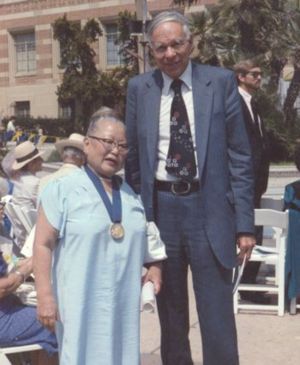 The Department of Chemistry and Biochemistry at
UCLA mourns the loss of Glenn Seaborg, an illustrious graduate, a dear friend, and an
ardent supporter. He passed away at the age of 86 in his home in Lafayette, California.
The Department of Chemistry and Biochemistry at
UCLA mourns the loss of Glenn Seaborg, an illustrious graduate, a dear friend, and an
ardent supporter. He passed away at the age of 86 in his home in Lafayette, California. GLENN THEODORE SEABORG
April 19, 1912, Ishpeming, MI - February 25, 1999, Lafayette, CA
 The Department of Chemistry and Biochemistry at
UCLA mourns the loss of Glenn Seaborg, an illustrious graduate, a dear friend, and an
ardent supporter. He passed away at the age of 86 in his home in Lafayette, California.
The Department of Chemistry and Biochemistry at
UCLA mourns the loss of Glenn Seaborg, an illustrious graduate, a dear friend, and an
ardent supporter. He passed away at the age of 86 in his home in Lafayette, California.
Glenn moved with his family from Ishpeming, Michigan, at the age of 12 to what was to become South Gate, California. At the age of 14, he began the practice of keeping a daily journal, which he continued for the rest of his life. It was not until he reached Jordan High School that his interest in chemistry was stimulated by the enthusiasm of a teacher, and, in September of 1929, he entered UCLA, majoring in chemistry. In 1934 he graduated from UCLA with highest honors, and later the same year he began graduate school in chemistry at UC Berkeley. After receiving his Ph.D. degree from UC Berkeley, he worked for two years as the personal research assistant to Prof. G. N. Lewis at the Berkeley campus. In 1939, he became an Instructor in the College of Chemistry at UC Berkeley.
The next phase of his life began in 1942, when he worked with Willard Libby and headed a group at the University of Chicago’s Metallurgical Laboratory, which devised the chemical extraction processes used in the production of plutonium for the Manhattan Project. It was in 1942 that he married Helen Griggs, formerly secretary to Prof. E. O. Lawrence. In 1944, Seaborg formulated the actinide concept of heavy element electronic structure, which accurately predicted that the heaviest naturally occurring elements together with the synthetic transuranium elements would form a transition series.
After the war effort, Helen and Glenn returned to Berkeley where he was Professor of Chemistry and where their children were born: Peter in 1946, Lynne in 1947, David in 1949, Stephen in 1951, Eric in 1954, and Dianne in 1959. In 1951, Glenn received the Nobel Prize in Chemistry with E. M. McMillan for his work on the chemistry of the transuranium elements. From 1958 to 1961, Glenn was Chancellor at UC Berkeley.
In 1961, Glenn was appointed Chairman of the Atomic Energy Commission by President John F. Kennedy. He was subsequently reappointed by both Presidents Johnson and Nixon, serving in that position until 1971. Upon his return to Berkeley, Seaborg continued working, until suffering a stroke in August of 1998. He was University Professor of Chemistry, an Associate Director of the Lawrence Berkeley Laboratory, and Chairman of the Lawrence Hall of Science at the University of California, Berkeley. He and his coworkers discovered ten transuranium elements and many isotopes that have practical applications in research, medicine, and industry. He has received honors far too numerous to mention and was, at the time of his death, the only living person to have an element, 106, Seaborgium, named after him. His daily diaries comprise over 90 volumes, part of an entire collection of about a half a million items deposited in the Library of Congress.